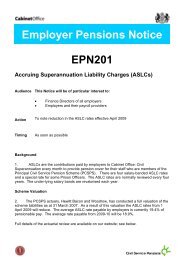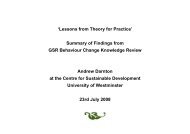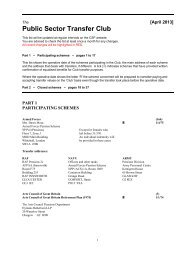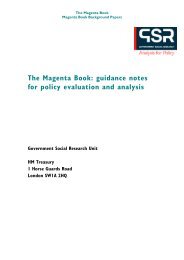Cultural Diversity - The Civil Service
Cultural Diversity - The Civil Service
Cultural Diversity - The Civil Service
You also want an ePaper? Increase the reach of your titles
YUMPU automatically turns print PDFs into web optimized ePapers that Google loves.
<strong>Cultural</strong> <strong>Diversity</strong>A resource booklet on religiousand cultural observance, belief,language and naming systems
ContentsIntroduction 1Religious Belief 3Buddhism 5Christianity 7Hinduism 9Islam 12Jainism 16Judaism 19Rastafarianism 21Sikhism 23Guidance on Naming Systems 25African Languages 28Languages of the Indian sub-continent 31Further information 34Produced by:<strong>Diversity</strong> and Equal Opportunities TeamHM Land Registry32 Lincoln’s Inn FieldsLondonWC2A 3PH
Land Registry <strong>Cultural</strong> <strong>Diversity</strong>IntroductionIn our commitment to diversity, jointly signed by the Chief Executive on behalf of theAgency Board and the DTUS Chair on behalf of the trade unions, we said“We must acknowledge, understand and appreciate the differences amongst us anddevelop a working environment that enhances rather than diminishes thesedifferences”Among our six commitments we set out to:“Ensure that all employees are aware of the Agency’s policy on managing diversityand take appropriate action to improve knowledge and understanding”and to “employ a workforce that reflects the diversity of local communities and societyas a whole, which values and respects the individual and provides all customers witha service that is fair and meets their diverse needs”.This resource booklet is designed to provide some general guidance on a range ofdifferent religions and cultures to help our understanding. Having a betterunderstanding of other religions and cultures helps us to value and respect them.We have made every effort to ensure that the information is accurate and up to date.However, it is not exhaustive and the information and guidance will not cover everysituation. We want to encourage a spirit of open and honest enquiry in the context ofmutual respect. At the end of the day there is no substitute for asking the individualquestions such as how they prefer to be addressed.It is also important to remember that valuing diversity is about acknowledging what wehave in common as much as about our differences. Increasing our knowledge of otherpeople’s cultures and beliefs will often lead us to recognise the similarities as much asthe differences. It will also help us to identify areas where there may be an impact inthe workplace such as standard hours working and religious observance duringRamazan (often written as Ramadan) or for Orthodox Jews.AcknowledgementsThis booklet has used the following sources and is grateful for their helpHM Customs & Excise booklet ‘Employing People of Different Religions’Home Office ‘A Brief Guide to Major Religious and <strong>Cultural</strong> Observance in the UK’Multicultural Matters Newsletter (www.multicultural-matters.com)COI Translations1
Land Registry <strong>Cultural</strong> <strong>Diversity</strong>A note on legislation<strong>The</strong> Race Relations Act 1976 (RRA) makes discrimination unlawful on the grounds ofrace, colour, nationality, ethnic or national origin in respect of employment and theprovision of goods and services. This is supplemented by a Code of Practice from theCommission for Racial Equality (CRE).Over the years tribunals and courts have established precedents about the definitionof ethnic origin and the scope of the legislation based on groups with a long sharedhistory and culture such as Gypsies, Sikhs and Jews. Currently Muslims andRastafarians are not covered by the RRA by virtue solely of belonging to thosegroups.<strong>The</strong> Race Relations Amendment Act 2000 (RRAA) strengthens the RRA by extendingprotection against racial discrimination by public authorities. It also places a new,enforceable duty on public authorities to have due regard to the need to eliminateunlawful discrimination and promote equality of opportunity and good race relations.<strong>The</strong>re is currently no specific legislation outlawing discrimination on the grounds ofreligion. However under proposals from the European Commission under Article 13 ofthe Treaty of Amsterdam, which all Member States have agreed, legislation will beintroduced making discrimination unlawful on grounds of religion or belief in the areasof employment and training.At present the likely timescale for legislation in the UK is December 2003.Although there is currently no specific legislation on religious discrimination it is againstRegistry policy to discriminate against or harass anyone on the grounds of religion.Such behaviour is unacceptable and will not be tolerated.2
Land Registry <strong>Cultural</strong> <strong>Diversity</strong>Religious BeliefWe all work with, or through our work come into contact with, people who havedifferent religious beliefs. We live in a multi-racial and multi-cultural society in which sixmajor world faiths are represented: Buddhism, Christianity, Hinduism, Islam, Judaismand Sikhism. An understanding of the history of these six major religions and theirbasic beliefs will help you to recognise some of the things which people from differentfaiths take for granted and which form part of their culture. It may help you inappreciating and responding to the needs of staff from minority ethnic communitiesand in developing effective liaison with those communities, particularly in recruitmentactivities. In fact, many people from minority communities define themselves more bytheir religious beliefs than by their ethnic origin.It is important to remember that all faiths are practised by people from differingbackgrounds and traditions and with varying degrees of adherence. For example, notall the Muslims you meet say their prayers five times a day, just as not all Christians goto church every Sunday. However, even people who do not strictly adhere to all of thepractices of their religion are affected by the beliefs, rituals and history of the faith theywere born into or later adopt.It is equally as important to recognise and respect those people who have no religiousbelief.<strong>The</strong> aim of this section is to give managers, colleagues and staff involved inrecruitment activities and those working with our customers a basic understanding ofthese different faiths, to help them to respond in a positive way to people whosebeliefs differ from their own.A note about languageIt is important to remember that in a diverse workforce we all need to make sure thatour language is sensitive and relevant and that we do not use words or phrases thatcould offend people, either intentionally or unintentionally. Sensitivity to other people’sbeliefs and cultures includes being aware that using the name of a particular God as aswear word often causes offence.A note about non-beliefPeople are non-believers for many reasons and it is important to respect non-belief too.Atheism is the absence of belief in God and takes different forms including Humanism,Secularism and Rationalism. Buddhism does not believe in a God and is a form ofatheism.3
Land Registry <strong>Cultural</strong> <strong>Diversity</strong>Agnosticism has come to mean a doubt about the existence of God. Popularlyagnostics don’t believe that God exists but they don’t believe that God doesn’t existeither.<strong>The</strong> original meaning of agnostic is someone who believes it is only possible to knowabout the material world and so we can never be certain whether God exists or not.4
Land Registry <strong>Cultural</strong> <strong>Diversity</strong>BuddhismBuddhism was founded 2500 years ago in North East India (Nepal) by PrinceSiddhartha Gautama who, after having undergone a spiritual experience now knownas Enlightenment, was thereafter known as Buddha, which means “the awakenedone”.<strong>The</strong>re are estimated to be 300 million Buddhists worldwide, the majority in South EastAsia and the Far East. Within the UK there are around 100,000 and this number isgrowing. Nearly every Buddhist tradition is represented in the UK, with approximately17 monastic centres and 18 meditation centres between them.Key beliefsBuddhists do not believe in a creator God, nor do they worship gods. Instead, theBuddha taught that a natural law of moral causation exists in the universe and thattransgression of this natural law brings with it certain adverse consequences. <strong>The</strong>essence of Buddhist belief is the doctrine of the Four Noble Truths, which wererevealed to the Buddha during his meditations:• suffering and imperfection are part of life (dukha);• they are caused by selfishness and desire (samodaya);• release from suffering is possible (nirodha);• it can be achieved only by following the ‘Eightfold Path’ which makes it possible toreach the state of bliss and freedom known as Nirvana (magga).<strong>The</strong> “Eightfold Path” consists of:• right understanding – to see life as it is and understand the Four Noble Truths;• right thought – a pure mind free from ill-will, lust and cruelty;• right action – love, charity, generosity, honesty, compassion etc;• right vocation – an occupation which harms no-one;• right speech – free from lies, harshness, gossip and slander;• right effort – to seek and maintain good;• right mindfulness – concentration to become aware of the truth about the body,mind, feelings and thoughts;• right concentration – meditation as a means to right understanding.5
Land Registry <strong>Cultural</strong> <strong>Diversity</strong>Buddhism is a very practical religion or way of life and aims at helping people to livehappily and harmoniously and to identify the path to Nirvana.Buddhists undertake to live according to five precepts:• to refrain from injuring living things;• to refrain from taking things which are not given;• to refrain from using one’s body to hurt or harm oneself or others;• to refrain from falsehood, prejudice and anything less than the truth;• to refrain from the abuse of elements which cloud the mind.<strong>The</strong>re is a general belief in rebirth with the status of the next life dependent on rightaction in the present one (karma).Buddhist Scriptures<strong>The</strong> basic collection of scriptures is made up of the teachings of the Buddha and isknown as the Pali Canon. <strong>The</strong> whole of this has been translated into English. <strong>The</strong>re isalso a vast collection of Buddhist writings in Sanskrit, Tibetan and Chinese.Places of WorshipBuddhists offer incense and flowers to the Buddha in their temples as an act ofrecollection and gratitude. Every Buddhist home also has a corner which is regardedas a shrine. <strong>The</strong> Buddha is not worshipped as a god, but venerated as a greatteacher who taught his people the way out of suffering.Main festivalsAll Buddhist festivals are celebrated on full moon days. <strong>The</strong> full moon day in Maycelebrates the birth, enlightenment and death of the Buddha.DietMany Buddhists are vegetarian, believing that it is wrong to kill or harm living things,although there are no special dietary rules.6
Land Registry <strong>Cultural</strong> <strong>Diversity</strong>ChristianityChristianity was founded about 2000 years ago and is based on the teachings ofJesus, known as Christ or Messiah, meaning “the anointed one”. <strong>The</strong>re are estimatedto be 1.2 billion Christians worldwide. Many different forms of Christianity arepractised in the UK, with an estimated total of 7 million adherents.Key beliefs and holy writingsChristians believe that God is a trinity of three persons in one: Father, Son (JesusChrist) and Holy Spirit. All have equal divine status. <strong>The</strong> doctrine of the Virgin Birth hasled, especially among Catholics, to the veneration of Mary, the mother of Jesus.<strong>The</strong> holy book of Christians is the Bible, which is in two parts: the Old Testament,roughly equivalent to the Hebrew Bible, and the New Testament, which includes theGospels (Jesus’ life and teachings) and the letters of St Paul and other saints, as wellas writings from other authors.Places of WorshipChristians normally worship in churches, which range in style and grandeur from StPaul’s Cathedral to small mission halls in urban areas and homes. However, there aremany different forms of meeting place.Holy days and festivals<strong>The</strong> Christian holy day is Sunday, when congregations gather for worship. <strong>The</strong> chieffestivals of the Christian year are:• Christmas. This celebrates the birth of Jesus. This is held on 25 December inWestern Christendom and on 6 January in Eastern Christendom.• Lent. A forty day preparation for Easter, during which time some Christians imposerestrictions on themselves, such as eating less or “giving something up”.• Easter. This commemorates the death (on Good Friday) and resurrection (onEaster Sunday) of Jesus. <strong>The</strong> exact dates, in late March or early April, vary fromyear to year.• Ascension Day. This celebrates Jesus’ ascension into Heaven, 40 days afterEaster.• Whitsun or Pentecost. This falls on the 7th Sunday after Easter and marks thecoming of the Holy Spirit on the first followers of Jesus.7
Land Registry <strong>Cultural</strong> <strong>Diversity</strong>Practices and symbolsUnlike the other two faiths of the Abrahamic tradition, Judaism and Islam, Christianityhas no special dietary laws, although some Christians abstain from alcohol andtobacco. Apart from the robes of church leaders (for those denominations withleaders), priests, monks and nuns, there are also no distinctive items of clothing. <strong>The</strong>symbol of the cross is, however, very significant for Christians, representing thecrucifixion of Jesus Christ. In recent years the symbol of the fish has also seen aresurgence. This is because the letters in the Greek word for fish can be related to thewords “Jesus Christ, Son of God, Saviour”.<strong>The</strong> central ritual of the majority of Christian worship is the Eucharist or HolyCommunion, a sharing of bread and wine which commemorates the last supper ofChrist with the apostles. Baptism is also a feature of most Christian denominations,whether of infants or adults.<strong>The</strong> black-led churchesOne of the areas in which Christianity is currently growing most rapidly is in the blackledchurches of the UK. <strong>The</strong>se churches represent 160 different denominations withover 100,000 members. Most of the churches are of African-Caribbean origin anddeveloped because some black people felt excluded in traditional English churches.<strong>The</strong> majority of African-Caribbean Christians now attend a black-led church, althoughnone of these churches exclude white members. <strong>Service</strong>s are generally longer andmore exuberant than the traditional “English service” and the interpretation of the Bibleis often more literal and conservative. One of the largest black-led churches in the UKis the New Testament Church of God, which has its headquarters in Northampton; ithas 30,000 members in over 100 congregations throughout the UK.Calendars<strong>The</strong> date of Jesus’ birth was established after the actual event and there is notcomplete agreement about the actual date. <strong>The</strong> Gregorian calendar assumed thatfrom the moment of Jesus’ birth it became the Year of Our Lord 1 (AD). <strong>The</strong> OrthodoxChristian Churches celebrate the Christian festivals on different dates to the West. <strong>The</strong>time lag arose following the adoption in the West of the Gregorian calendar.8
Land Registry <strong>Cultural</strong> <strong>Diversity</strong>HinduismHinduism is the name of the religion of the majority of people living in India; the namederives from a word meaning “India”. It is an ancient religion, with such a wide varietyof practices and beliefs that the following information cannot do more than scratch thesurface and indicate some of its more common features. Worldwide there areestimated to be around 500 million Hindus, the majority in India. Hindus in Britainnumber about 400,000 with sizeable Hindu communities in London and Leicester.Key BeliefsHinduism is a religion personified by many gods, who are themselves regarded asmanifestations of different attributes of one supreme God. <strong>The</strong> three main gods areBrahma, creator of the world, Vishnu, preserver of the world and Shiva, the destroyer.Vishnu is often worshipped in the form of his incarnations, Krishna and Rama.At the heart of Hindu philosophy lie the concepts of:• reincarnation;• karma, or past action, and the belief that right living and good deeds in one lifelead to reincarnation in a higher form or salvation; and• dharma or duty, appropriate to an individual’s status and caste in the present life.Holy writings<strong>The</strong> most revered of the Hindu sacred writings are the Vedas. <strong>The</strong> Bhagavad-Gita isanother very popular Hindu sacred book and forms part of the Mahabharata epic,which recounts the deeds of the Hindu gods, thousands of years ago.Places of worshipIn India, Hindu temples are usually places where the priests serve the gods on behalfof the people. Only at festival times do they become the focal point of congregationalworship. Daily worship is offered in the home.Although Hindus in the UK still worship mainly at home, more emphasis is placed onregular congregational worship in the temple. Before entering the temple the handsare washed and shoes removed. <strong>The</strong> central ceremony includes lighting the sacredfire using ghee (clarified butter) as well as prayers and the singing of hymns.<strong>The</strong> river Ganges in India has a particular significance for Hindus; it is a holy river andHindus who bathe in it believe they are purified.9
Land Registry <strong>Cultural</strong> <strong>Diversity</strong>Main festivals<strong>The</strong> principal festivals of the Hindu year are:• Holi. An exuberant spring festival which takes place in February or March and isassociated with Krishna.• Maha Shivratri. A festival for Lord Shiva usually in February or March.• Ramnavmi. Lord Rama’s birthday usually in April.• Janmashtmi. Lord Krishna’s birthday usually in August.• Navratri. A nine nights festival as a prelude to Dasara.• Dasara (Dassehra). A celebration in honour of Rama, which occurs in Septemberor October.• Diwali. <strong>The</strong> New Year Festival, which takes place around October or November. Ithas light as its theme and is often celebrated with fireworks.Diwali – <strong>The</strong> Indian Festival of LightsIn India, Diwali, the festival of lights, marks the new year on the Hindu calendar.People worship the goddess of wealth, pray for the prosperity of the world, meet andgreet friends and relatives, wear new clothes, exchange gifts and sweets and set offfirecrackers. People share food and clothing with those in need.Diwali is a time for fun and revelry. Diwali is also time for pooja and traditions. Just asone cannot imagine Diwali without crackers and sweets; so too one cannot imaginethis festival without the rituals of lighting the lamp and Laxmi pooja. Each of thesetraditions are rooted in beliefs that have been established by Indian culture and Hindureligion.<strong>The</strong> festival of Diwali is celebrated on the amavasya (moonless night) of the month ofAshwin (October – November). It celebrates the victory of good over evil and the gloryof light. <strong>The</strong> common story of Diwali concerns the return of Lord Rama, a Hindu god,to his kingdom, after 14 years of exile. People of all castes and creed meet andcelebrate Dipawli, commonly known as Diwali.Diwali is one of India’s most auspicious celebrations. <strong>The</strong> holiday commemorates the“home-coming” of Lord Rama and Sita. It’s the biggest holiday in India, and signifiesthe beginning of the new year too.<strong>The</strong> day is also marked by “Laxmi pooja”, where Laxmi, the goddess of wealth isworshipped for prosperity and happiness.It is believed that for these few days of Diwali, the souls of the ancestors return totheir earthly homes, to share a few moments with their living relatives. Thus, it is10
Land Registry <strong>Cultural</strong> <strong>Diversity</strong>important to be bright and happy on these days. <strong>The</strong> spirits of the ancestors partakeof the happy company in their households and then return satisfied to the netherworld.In presentation of Diwali, homes in India are whitewashed, painted and decorated. Atsundown houses are lit up with diyas, small earthenware lanterns. It is a time ofhappiness, love, forgiveness and thanksgiving. Everywhere there is a joyousatmosphere.Dietary laws and dressMost Hindus do not eat beef, or are completely vegetarian, and many do not useeither tobacco or alcohol.Many Hindus wear Western clothes, although at home and on social occasions evenWesternised Hindu women will often wear a sari. In fact, saris have now becomemore popular among younger Hindu women in this country. Hindu women often weara red spot, known as a tika, on their forehead.<strong>The</strong> caste systemHistorically, Hindus have been identified with the caste system. Although the castesystem remains important in India, attitudes and practices have changed. Forexample, Mahatma Gandhi ensured that, by law, no person could be ascribed to thelowest caste and everyone had a right to enter the temples. Educated Hindus nowcome from all castes and the system is considered outdated.Upon entering a Hindu home, do not offer to shake hands. An acceptable greeting isthe ‘Namaste’ (hands raised palm to palm and slight bow of head). Shoes must beremoved in the area of the house which accommodates a shrine. When Hindu womenare addressed by a man, another family member should be present.11
Land Registry <strong>Cultural</strong> <strong>Diversity</strong>IslamIslam was founded about 1400 years ago by the Prophet Muhammad; people whofollow this faith are known as Muslims.Muslims number about 1 billion worldwide, with an estimated 2 million living in Britain.Most Muslims in Britain originate from the Indian subcontinent – India, Pakistan andBangladesh – as well as from East Africa, the Middle East and North Africa.Key BeliefsMuslims believe in one God whose name in Arabic is “Allah”. <strong>The</strong>y also honour asuccession of prophets from Abraham and Moses, through Jesus to Muhammad inthe 7th century, but do not regard Jesus as divine.Muslims are required to follow the “Five Pillars of Islam”:• affirmation that there is no other God but Allah (Shahada);• five daily ritual prayers, at dawn, noon, mid-afternoon, sunset and night (Salah);• fasting during the month of Ramazan (often written as Ramadan). To keep strictly tothe fast, Muslims will abstain from food and drink from dawn until sunset (Sawm);• giving money to the poor (Zakah); and• making a pilgrimage to Islam’s most holy shrine, the place of the ProphetMuhammad’s birth at Mecca, at least once in a lifetime (Hajj).Holy writings<strong>The</strong> holy book of Muslims is known as the Qur’an, which contains the revelationsgiven by God to Muhammad.Places of WorshipMuslims worship in mosques, which are social centres and centres of learning, as wellas places of worship. <strong>The</strong> best way to approach the local Muslim community isusually through the mosque. <strong>The</strong> Imam (religious leader) or the mosque secretary arethe best people to contact initially.Dietary laws and dressMuslims do not eat pork or ham and many eat only halal meat (from animalsslaughtered in a ritually acceptable way). Alcohol is forbidden to all Muslims.12
Land Registry <strong>Cultural</strong> <strong>Diversity</strong>Most Muslim women dress modestly and some keep their head covered at all times. Ifa non-Muslim woman enters a mosque it is appreciated if she too covers her head asa mark of respect. In the prayer hall itself, shoes are removed by both men andwomen.Holy days and festivals<strong>The</strong> Islamic holy day of the week is Friday and communal prayers are said at mid-day.One of the most important festivals in the Islamic calendar is Id al-Adha (the festival ofsacrifice) which is celebrated over four days, to mark the ritual slaughter of a lamb bythe Prophet Abraham, in the place of his son. <strong>The</strong> end of the period of Ramazan ismarked by the festival of Eid al-Fitr.A Brief Note about RamazanRamazan – Festival of Charity and PietyRamazan (often written as Ramadan) is the ninth month of the Islamic calendar. This isthe month of fasting (Sawm). It begins with the sighting of the new moon. <strong>The</strong> monthof Ramazan is part of the lunar calendar and since this is eleven days shorter than theGregorian calendar, Ramazan comes eleven days earlier every year which allowfasting in various seasons and weather throughout a life time.What is sawm?Sawm or fasting during the holy month of Ramazan is the fourth pillar of Islam. <strong>The</strong>fast is an act of deep personal worship in which Muslims seek a richer perception ofGod. Sawm during Ramazan or any time is recognised as physically demanding butspiritually rewarding.It is the duty of all healthy Muslims to observe the fast for this whole month. It is doneso that Muslims will know what humility is. Fasting is also an exercise in self-controlwhereby one’s sensitivity is heightened to the sufferings of the poor.Who it is prescribed upon?Fasting of Ramazan is an act of worship which is required of every adult Muslim maleor female if he/she is mentally and physically fit and not on a journey. Exceptions:women during their period of menstruation and while nursing their child, and also incase of travel and sickness for both men and women. If they are unable to fast, theymust feed a needy person for every day missed.13
Land Registry <strong>Cultural</strong> <strong>Diversity</strong>Abstention and self-controlAbstention means abstention completely from eating, drinking and intimate sexualcontact from dawn to dusk and curbing even the smallest of evil intentions anddesires.Fasting does not mean starvation since food and drink are permitted at night althoughit is recommended they are taken in a mood of asceticism. As one conquers the dailyroutines of eating, drinking and endures hunger and thirst, Ramazan furnishes a firstclassdrill in self-restraint and will power.Eating and drinkingRamazan is also a joyful month. Muslims break their fast at sunset with a specialmeal, IFTTAR and perform additional worship, TARAWIH, after an evening prayer.Improving physical and mental healthA fast does have positive health benefits. <strong>The</strong> stomach has been working for 24 hoursa day non-stop, so fasting will give it a rest. Although beneficial to health it is regardedprincipally as a method of self-purification. By cutting oneself off from worldlycomforts, even for a short time, a fasting person gains true sympathy with those whogo hungry as well as spiritual growth. Fasting is a very enriching experience as onetranscends the needs of the body and cherishes the spiritual aspects. <strong>The</strong> monthpasses quickly and is almost like recharging one’s batteries for rest of the year.Teaching mankindFasting teaches humans the principle of sincere love of God. It teaches patience, unselfishness,moderation, will power, discipline, spirit of social belonging, unity andbrotherhood.What happens at the end of RamazanAt the end of the holy month of Ramazan, comes the occasion of celebration calledEID UL FITR. Prior to the commencement of festivity of EID, it is compulsory for wellto do Muslims to donate a prescribed amount to charity. Festivities of “EID” begin withan EID prayer in the morning. Customarily, it is a time for family reunion and thefavoured holiday for children who receive new clothing and gifts from family membersand friends.Ramazan begins on or near:November 6 2002October 27 2003<strong>The</strong> exact date depends on the sighting of the new moon.14
Land Registry <strong>Cultural</strong> <strong>Diversity</strong>Other points to noteMuslims form two distinctive groups, the Sunni Muslims and the Shi’a or Shi’iteMuslims. <strong>The</strong> former is the mainstream, orthodox branch of Islam and accounts for88% of the Muslims in the world. <strong>The</strong> Shi’a are mainly concentrated in Iran, Iraq,Pakistan and India.Recent world events have caused Islam to be misrepresented in the minds of manypeople. In fact, its teaching strongly emphasises the brotherhood of mankind and setsthe tone for most Muslims’ relationship with others.15
Land Registry <strong>Cultural</strong> <strong>Diversity</strong>Jainism<strong>The</strong>re are thought to be between 25-30,000 Jains in Britain. Estimates vary althoughthe community is probably growing.No statistics are officially collected but community sources say that the most popularareas for the Jain community are North West London, Leicester and Coventry. In theUK there are four Jain places of worship of which three are in the Greater Londonarea and one in Leicester.<strong>The</strong> precise origins of Jainism cannot be traced, but it began in India. <strong>The</strong> term Jainmeans a follower of the Jinas (Spiritual Victors), a line of human teachers who arebelieved to have existed from time immemorial and to have attained kevalajnana(infinite knowledge) and perfect purity through their own spiritual efforts. <strong>The</strong> Jinas arealso known as Tirthankaras. Jains believe that in the present cosmic cycle there havebeen twenty-four Tirthankaras who have taught others the tenets of Jainism.<strong>The</strong> twenty-fourth Tirthankara was Vardhamana, usually called Mahavira (the GreatHero).When he was thirty years old he left home on a spiritual quest. Jains affirm that aftertwelve years he attained kevalajnana (omniscience). Shortly after this, eleven learnedmen came to the place where Mahavira was in order to challenge him, but when heanswered their doubts they became his disciples and later on the Ganadharas(leaders) of the fourfold order of monks and nuns, laymen and laywomen which hefounded.Key beliefs and holy writingsJain scriptures are known as the Shruta, Agamas or Siddhanta (doctrine) whichcomprise the canonical literature containing the teachings of Mahavira and otherTirthankaras.Ahimsa<strong>The</strong> cardinal principle of Jainism is ahimsa, generally translated as non-violence,although it goes far beyond that to encompass the avoidance of all physical or evenmental harm to any living being.Jainism is a religion without a belief in a creator god. According to its scriptures, thereis akasha (infinite space) within which there is a finite area called loka (the universe).Within this universe there are an infinite number of jiva or atmas (sentient beings).16
Land Registry <strong>Cultural</strong> <strong>Diversity</strong>A lay person who undertakes to refrain from all forms of intentional violence expressesthis by assuming the anuvratas (five life-long minor vows).<strong>The</strong> vow of ahimsa (not harming) is the cardinal principle of Jainism. It includes nothurting sentient beings, and is therefore expressed in a strictly vegetarian diet. Jainscriptures permit the consumption of dairy products such as milk, curds and ghee(clarified butter), but prohibit the eating of meat, eggs and honey.<strong>The</strong>y also prohibit the consumption of certain vegetables that grow underground suchas potatoes, or fruits with many seeds such as figs, as well as fermented productssuch as alcohol.Some lay people, as well as all mendicants, observe the restriction of not eating aftersunset or before sunrise.<strong>The</strong> principle of ahimsa also underlies the remaining vows of satya (truthfulness),asteya (not stealing), brahmacharya (refraining from sexual activity outside of marriage)and aparigraha (placing limits on one’s possessions). Employment is also restricted tooccupations where there is only a minimal likelihood of harm to human or animal life.Jains consider that the true path of emancipation does not begin until one renouncesthe household altogether in order to lead the celibate life of a sadhu (male mendicant)or sadhvi (female mendicant) by taking the mahavratas (the great vows). <strong>The</strong> vowstaken by a mendicant are the same as those taken by a lay person, but are muchmore restrictive.Personal PujaJains may offer puja (worship) at their home shrines three times a day, before dawn, atsunset and, at night, by chanting mantras (litanies). <strong>The</strong> second important ritual ispratikramana, a confession of transgressions against one’s religious vows committedknowingly or unknowingly.<strong>The</strong>re are two main monastic groupings, the Shvetambara (originally known as whiterobed, whose monks and nuns wore simple clothing) and Digambara (originally knownas sky robed who, believing that clothing was a possession, went naked). <strong>The</strong>seterms are also used to describe their lay followers. <strong>The</strong>re is not a great deal oftheological disagreement between them, most of the differences revolve around whichHoly Scriptures are used. <strong>The</strong> Shvetambaras are thought to be the most common inthe UK.Jains do not believe in the caste system. Family life is extremely important:relationships outside marriage are not acceptable and people honour their parentsthroughout their lives. Education is vital and many people go into the professions,traditionally those that require science qualifications.17
Land Registry <strong>Cultural</strong> <strong>Diversity</strong>Language<strong>The</strong> main community language is Gujarati but almost everyone will be fluent in spokenand written English. Many older people will also be able to speak East Africancommunity languages. About 5% of Jains speak Hindi, Punjabi or Marwari.Main festivalsMahavira Jayanti (March/April)Marks the anniversary of the birth of Mahavira.Akshaya-tiritiya (April/May)Means “Immortal Third” and celebrates the first time that alms were given to JinaRishabha, the first Tirthankara of this cosmic cycle.Shruta-pancami (May/June)Or Guru-pancami, meaning “Teacher’s Fifth”, is celebrated by the Digambaras on thefifth (pancami) day of May/June. Among the Shvetambaras this day is known asJnana-pancami (Knowledge-Fifth) and is observed in October/November. Itcommemorates the day on which the Jain scriptures were first written down.Paryushana-parva (August/September)A period of eight to ten days which marks the most important religious period duringthe four months of the rainy season in India. During this time, lay people often observespecial vows of eating only one meal or of fasting from sunrise to sunrise.During the festival, each day is devoted to a discourse on one of ten virtues. <strong>The</strong> finalday is the holiest in the year and is marked by the celebration of Samvatsaripratikramana.This is an annual ceremony of confession in which all Jains participate,requesting forgiveness from relatives and friends for offences of thought, word ordeed.Vira-Nirvana (November)This coincides with the Indian festival of Diwali, when Jains mark the death andnirvana of Mahavira.Karttika-purnima (December)Is the day on which the rainy season retreat for monks and nuns comes to an end,and they resume their travels on foot. This marks the end of the Jain religious year.18
Land Registry <strong>Cultural</strong> <strong>Diversity</strong>JudaismJudaism was founded about 4000 years ago by Abraham, who taught his people toworship one God – Jehovah or Yahweh. <strong>The</strong> character of the Jewish faith has beenshaped by its history of exile and persecution. <strong>The</strong> most traumatic event in modernJewish history was the Holocaust, when Hitler attempted the genocide of the Jewishpeople. Jews currently number about 15 million worldwide, with approximately300,000 in the UK. <strong>The</strong> largest UK communities are in Greater London, Manchesterand Leeds.Key beliefs and holy writingsJews believe in one God and assert this daily in their prayers. <strong>The</strong> Old Testament ofthe Bible contains the sacred Jewish writings. <strong>The</strong> first five books comprise the Torahand reveal the will of God. <strong>The</strong>y are central to the Jewish faith.Places of worship<strong>The</strong> Jewish centre of worship is the synagogue; the Hebrew word means “to gathertogether”. It is the focal point of Jewish activity, being the place for prayer, meetingothers and a centre of administration. <strong>The</strong> Rabbi is a teacher to the community. <strong>The</strong>Rabbi’s time is spent partly in pastoral duties, studying, teaching and sometimesconducting services.Holy days and festivals<strong>The</strong> Jewish holy day is Saturday, the Sabbath (Shabbat), which runs from sunset onFriday to nightfall on Saturday. It is a day of rest and prayer, and is strongly familycentred.Jews who observe the Sabbath strictly need to be able to leave the workplace on Friday in time to be home before sunset.<strong>The</strong> main festivals of the Jewish year are:• New Year (Rosh Hashana). <strong>The</strong> Jewish calendar is based on the cycles of themoon and the New Year occurs in September or October. It is marked by twodays of reflection and prayer.• Day of Atonement (Yom Kippur). This follows ten days after the New Year and isthe most solemn day in the Jewish calendar. It is spent in prayer and a 25 hourfast.• Sukkot. Five days after Yom Kippur, this is also known as the Feast of Tabernaclesand commemorates the Biblical story of the Jews wandering for 40 years in thewilderness.19
Land Registry <strong>Cultural</strong> <strong>Diversity</strong>• Hannukah (sometimes spelt Chanukah). A festival of lights which commemoratesthe rededication of the temple in ancient times. <strong>The</strong> festival lasts for a week andeach night candles are lit on a 9 branch candelabra, known as a ChanukahMenorah. It is celebrated during November and December.• Passover (Pesach). A Spring festival which commemorates the deliverance ofIsrael from slavery in Egypt.DressMost of Britain’s Jewish people dress in the same way as the wider community. It istraditional for men to cover their head when in the synagogue and devout Jewish menand boys wear a skull cap at all times. <strong>The</strong>re is one group, however, which isparticularly distinctive in its manner of dress. Male Hassidic Jews (chiefly from EasternEurope) wear dark clothing and wide brimmed hats, and curl their side burns.Dietary Laws<strong>The</strong> Jewish faith has many dietary laws; the extent to which they are upheld willdepend on the individual and the degree of their orthodoxy. Many Jews do not eatpork, or shellfish, or dairy and meat products at the same meal. Food which has beenprepared in a ritually acceptable way is known as ‘Kosher’. In the case of meat, forexample, this means that the animal has been slaughtered by a qualified person in away which allows its blood to drain away. In the case of other food, there must havebeen no contact with banned items. An example of this would be an egg which, iffried in bacon fat, would not be permissible.Rites of passageAll Jewish boys are circumcised eight days after birth. <strong>The</strong>y are considered to come ofage in a religious sense at 13 when their Bar-Mitzvah ceremony is held. <strong>The</strong> Jewishmarriage is both a contract and a holy covenant. Divorce is permitted after allattempts at reconciliation have failed. Most Jews bury their dead, as cremation isstrictly prohibited in Jewish law. This is followed by a week of private mourning and bya further ceremony one year after the death.20
Land Registry <strong>Cultural</strong> <strong>Diversity</strong>RastafarianismRastafarianism dates back to the early 1930s when the Prince Regent, Ras (‘Prince’)Tafari, was crowned as Emperor Haile Selassie 1 of Ethiopia (1930-74). It is from RasTafari that this Revivalist Movement gained its name. Rastafarians believe in one God(Jah) and that they and all Africans who have migrated are but exiles in ‘Babylon’.<strong>The</strong>y are destined to be delivered out of captivity by a return to Zion or Africa – theland of their ancestors. <strong>The</strong>re are believed to be about 250,000 adherents to thisreligion world-wide, of whom approximately 5,000 live in the United Kingdom.Key beliefs<strong>The</strong> modern characteristics of the Rastafarian movement include a loosely definedbelief system, due to its lack of a single authoritative voice. Some consider theRastafarian movement to be influenced by Marcus Garvey’s own set of beliefs. Heestablished the Universal Negro Improvement Association in 1914 in both the UnitedStates and Jamaica. This organisation was the vehicle for Garvey’s aim to return Blackto Africa. His teaching remains the key influence upon this Black religion. Garvey wasthought to have predicted the coronation of Emperor Haile Selassie with his allegedphrase “Look to Africa when a Black king shall be crowned, for the day of deliveranceis near”.Despite the lack of a central authority, Rastafarianism is guided by key tenets of faith.<strong>The</strong> Bible is the main religious text of Rastafarianism. <strong>The</strong> African race is one of God’schosen races, one of the twelve Tribes of Israel. Jamaica is the biblical ‘Babylon’,although all the places to which Africans have been exiled are also included. ‘Babylon’is the place which will never see spiritual reform and liberation. ‘Jah’ is believed toreside in each person and there is ‘Oneness’ between the individual and God.Revivalism, the belief that they are destined to be delivered out of captivity by a returnto Zion or Africa, is the key tenet of faith held by the adherents to Rastafarianism.Rites and observancesWorship takes place at various times depending upon each Rastafarian commune.Nevertheless, a service is conducted at least once a week. Central to the service ismusic and, sometimes I-TAL (vegetarian, organic and natural food prepared in thecolours red, green and gold). Fasting is observed, sometimes as often as twice eachweek or simply on the first Saturday of every month. On these days, nothing whateveris consumed from noon until evening. Adherents to Rastafarianism consider Saturdayto be the Sabbath day. Cutting of hair is prohibited. Dreadlocks symbolise the ‘maneof the Lion of Judah’ (reference to the divine title of Emperor Haile Selassie).21
Land Registry <strong>Cultural</strong> <strong>Diversity</strong>Language, Culture and DietSince the Second World War, the influence of Rastafarianism on Jamaican society hasbeen very significant. Music, language and cultural styles of dress have becomesymbolic of both Jamaica and Rastafarianism. As a consequence, it is difficult toascertain where Rastafarianism ends and Jamaican culture begins. It would be amistake to assume that everybody wearing their hair in dreadlocks or even the ‘Tam’(a woollen hat used by ‘Dreads’ to cover their locks) is an adherent of Rastafarianism.Nevertheless, some adherents choose to express themselves in music rather thanreligious observance. Furthermore, the vocabulary of Rastafarianism is largely that ofJamaican Patois. Rastafarianism has, in the past, played a significant role in thepolitics of Jamaica. Indeed, Rastafarians remain very critical of many aspects ofJamaican politics and way of life.Most adherents of Rastafarianism are vegetarian and avoid stimulants such asalcohol, tea and coffee. However, marijuana (ganja) is consumed and plays asignificant role within Rastafarianism.A note on Social life and the role of WomenWithin Rastafarian communities, men and women play distinct roles and have differentstatus. Traditional Rastafarianism, in its attitude and expectations of women (womyn),is very similar to traditional Judaism and Islam. Just as women’s equality has becomea serious issue in other faiths, Rastafarianism is adopting more open-minded andprogressive ideas about women. It is accepted that women, within the Rastafarianreligion, may become educated. Abortion or birth control are opposed.Main FestivalsBirthday of Emperor Haile SelassieEthiopian Christmas23 July7 January22
Land Registry <strong>Cultural</strong> <strong>Diversity</strong>Sikhism<strong>The</strong> Sikh religion was founded in Northern India in the fifteenth century by GuruNanak. It was originally conceived as a synthesis between Hinduism and Islam, butrapidly took its own distinctive identity.<strong>The</strong>re are estimated to be about 20 million Sikhs throughout the world, with around500,000 in Britain. <strong>The</strong> Sikh community in Southall, London, represents the largestconcentration of Sikhs outside the Indian sub-continent.Key beliefsSikhs believe in one God, whose word was revealed to mankind through ten majorprophets called “Gurus”. Salvation comes from achieving union with God throughdevotional worship. Until that union is achieved, Sikhs believe they must live throughmany reincarnations.Holy writings<strong>The</strong> holy texts are known as the Guru Granth Sahib and consist of a collection ofhymns and prayers of the Gurus. <strong>The</strong>y include texts from followers of other faiths suchas Islam and Hinduism.Main festivalsBaisakhi is the most important of the Sikh festivals and falls on or around 13 April,marking the beginning of the Sikh New Year.<strong>The</strong> festival of Hola Mohalla is celebrated in February or March over a three dayperiod, and was originally adapted from the Hindu festival of Holi.Diwali falls in October or November and is a similar festival to that of the Hindus, withcentral themes of light and joy.Most Sikhs also celebrate the birthdays of the first and last Gurus, and the martyrdomof the fifth Guru, Arjan Dev and the ninth Guru, Teg Bahadur.Holy places<strong>The</strong> Sikh temple is known as a Gurdwara and is the focus for public worship. Templesrange in size from the Golden Temple in Amritsar, the focal point of the Sikh religion,to converted houses in urban Britain.23
Land Registry <strong>Cultural</strong> <strong>Diversity</strong>Guidance on Naming SystemsIntroductionAs not everyone you come across will be a Christian you should ensure that you avoidusing the term ‘Christian name’ and use ‘first name’ instead.Chinese<strong>The</strong> traditional Chinese naming system places the family name first followed by thepersonal name. Chinese people living in the UK may use either the traditional methodor the UK system where the personal name comes first followed by the family name.In China around 90% of people share around 100 family names and 70% share 50names. <strong>The</strong> most popular family names are: Zhang, Wang, Li, Zhao, Chen, Yang, Wu,Liu, Huang and Zhou.<strong>The</strong> family name is nearly always followed by a two-part personal name. <strong>The</strong> twonames are usually hyphenated and should be used together.Gujarati<strong>The</strong> basic pattern for males is:Personal Name – Father’s Personal Name – Family NameFor example:Father’s name – Karam Chand GandhiGiven name – Mohan DasFull name – Mohandas Karamchand Gandhi<strong>The</strong> basic pattern for females is normally to have a personal name and a family nameonly.Patel and Shah are very common names within the Gujarati community.As a sign of respect title affixes are often used:Ji, Bhai and Lal for males, e.g. Gandhiji.Bai or Min for females.25
Land Registry <strong>Cultural</strong> <strong>Diversity</strong>Hindu<strong>The</strong> basic pattern is:Personal Name – Complementary Name – Subcaste Name(First Name) (Middle Name) (Family Surname)<strong>The</strong> personal name usually indicates the sex of the owner, e.g. Arima = female,Naresh = male.<strong>The</strong> complementary name is like a second first name; it is not a surname.Some common middle names are:Lal, Nath, Chand, Kumar, Ram = maleDevi, Kumari, Bai = female<strong>The</strong> “subcaste” name is not exactly equivalent to a UK surname.This name, to someone who understands the caste system, gives information aboutthe social status and traditional occupation of its owner.It should be borne in mind that attitudes and practices have changed and the Indianconstitution frowns on the caste system. <strong>The</strong>refore, because caste is built into theHindu naming system, many Indians have now stopped using the subcaste name.This can cause some confusion because the middle name, used as a surname is notcommon to all members of the same family.MuslimA typical pattern is:Religious Name(s) – Personal Name – Clan/Family/Regional Name<strong>The</strong> religious name is not used as a personal name but is in fact a religious title. <strong>The</strong>most common one is Mohammed, but any of the 99 names of Allah may be given.Other names include Abdul, Allah, Ullah.<strong>The</strong> titles Allah and Ullah are usually used together with the personal name, e.g. AllahDittah, Hafeez Ullah.As the personal name may come first or may be followed by another religious name orused with a title, the real personal name (the one by which a person should beaddressed) can normally only be established by asking the individual.Examples (with personal name underlined)Abdul Aziz, Syed Khalid Hussein<strong>The</strong>re is no equivalent to our surname. Some Muslims have a final name which maybe a clan, regional or family name or a title and may be used as a surname in ourterms. However, as with Hindu family names these are associated with social position.26
Land Registry <strong>Cultural</strong> <strong>Diversity</strong>Thus when Muslims feel they are doing well in life they might, if they are traditionalists,decide to add a name of this sort.Some examples are: Khan, Shah, Chaudry, Bhatti.Conversely, many Muslims in this country, particularly the young have dropped theirfinal name and adapted to our system by using only two names.It must be remembered that members of the same family usually have completelydifferent names thus kinships cannot be identified or assumed.Sikh<strong>The</strong> basic pattern is:Personal Name – Singh or Kaur – Family Name(First Name) (Religious Identification)<strong>The</strong> personal name is similar to the UK forename but the same name can be given tomales and females.<strong>The</strong> religious identification names of Singh and Kaur were originally complementarymiddle names on the Hindu naming pattern. Singh, meaning lion, is taken by all maleSikhs and Kaur, meaning princess, by all female Sikhs.<strong>The</strong> family name is often associated with place of origin or caste and is avoided bymany Sikh families. <strong>The</strong> use of Singh and Kaur as ‘surnames’ means a great deal toSikhs as a mark of religious identification and rejection of the caste system. Onmarriage a woman takes her husband’s family name where he uses it, otherwise shecalls herself Mrs Kaur or sometimes Mrs Singh.27
Land Registry <strong>Cultural</strong> <strong>Diversity</strong>African LanguagesAfrica is the most linguistically diverse continent in the world with at least 1,000spoken languages; Nigeria alone has more than 400. <strong>The</strong>re are about 20 mainlanguages but they are spoken by only half the people so everybody is used to havingto be multilingual. In addition to English, most people will be able to speak the locallingua franca and their own community language. People may have much moredifficulty reading any of the languages; with such diversity, Africa struggles to produceschool textbooks and mass media in the smaller community languages.<strong>The</strong>re are four main language groups; the two largest are the Niger-Congo and theAfro-Asiatic groups with about 300m and 200m speakers respectively. People whobelong to one of the major groups share a basic vocabulary and construct sentencesin a similar way. <strong>The</strong>re are no guarantees that people within the same group or subgroup will necessarily understand each other but they may be able to conduct a verybasic conversation, in much the same way that the Italians and the Spanish could.Mutual understanding would however be very limited; after all, even though Englishand Dutch are both Indo-European-Germanic languages, the average Brit does notunderstand Afrikaans. It is more likely to happen if there is very close geographicalproximity between the countries of origin of the two native speakers. Difficulties alsoarise because most of the African languages are tonal and different pronunciations ofthe same word have vastly different meanings.<strong>The</strong> following chart lists some of the most popular languages that are spoken byBlack African communities in the UK. <strong>The</strong> total number of speakers is the estimatednumber of speakers within the whole of Africa. It includes native and non-nativespeakers.28
Land Registry <strong>Cultural</strong> <strong>Diversity</strong>Language Spoken in No.Afrikaans Namibia, South Africa 10mAkan/Twi-Fante Ivory Coast, Ghana 7mAmharic Ethiopia 20mArabicAlgeria, Chad, Comoros, Djibouti, Egypt,Eritrea, Libya, Mauritania, Morocco,Somalia, Sudan, Tunisia230mFulani/Fulfulde Burkino Faso, N Cameroon, Chad,Gambia, Guinea, Mali, Mauritania, Niger,Nigeria, Senegal13mHausaCameroon, Côte d’Ivoire, Ghana, Senegal,S Niger, N Nigeria39mIbo/Igbo Niger, Nigeria 17mKikuyu WC Kenya 5mLingala Democratic Republic of Congo 7mMalinke/Mandingo Guinea, Gambia, Mali 9mOromo W Ethiopia, N Kenya 9mShona Botswana, Zimbabwe 8mSomali Djibouti, Ethiopia, Kenya, Somalia, Yemen 4mSwahiliDemocratic Republic of Congo, Kenya,Mozambique, Sudan, Tanzania, Uganda,Zaire, Zimbabwe49mTigrinya Ethiopia, S Eritrea, Tigre 4mWolof Gambia, Senegal 7mXhosa South Africa 8mYorubaBenin, Côte d’Ivoire, Dahomey, Ghana,Nigeria, Togo, Sierra Leone20mZulu Lesotho, South Africa 9m29
Land Registry <strong>Cultural</strong> <strong>Diversity</strong><strong>The</strong> former colonial languages, English, French, Portuguese and Italian are in use aslingua francas; adaptations of indigenous languages are also used in trade and almosteveryone who has not been born in the UK will have a working knowledge of one orother of them. Former British colonies obviously use English; older inhabitants offormer French colonies may speak French although as English gains in strength as thelanguage of mass communication, most people living in the UK will have no problemwith it.Colonial LanguageLingua FrancasEnglish French Language RegionBotswana Benin Arabic North AfricaCameroon Burkina Faso Bambara West, West-centralAfricaEgypt Burundi Fanagalo South AfricaGambia Cameroon Fulani West AfricaGhana Central African Rep. Hausa West, North-centralAfricaKenya Chad Krio West AfricaLesotho Comoros Lingala Central AfricaLiberia Congo/Democratic Sango Central AfricaRep. of CongoMadagascar Côte d’Ivoire Swahili East and Central AfricaMalawi Djibouti Wolof West AfricaMauritius Egypt Yoruba West-central AfricaNamibiaNigeriaSierra LeoneSomaliaSouth AfricaSwazilandTanzaniaUgandaZambiaZimbabweGabonGuineaMadagascarMaliMauritaniaNigerRwandaSenegalTogoTunisiaGuidance provided by kind permission of Multi-<strong>Cultural</strong> Matters (020 8343 2371;www.multicultural-matters.com).30
Land Registry <strong>Cultural</strong> <strong>Diversity</strong>Languages of the Indian sub-continentAccording to the last published Census, almost 1.5 million people now living in the UKdescribe themselves as being either Indian, Pakistani or Bangladeshi. Most of thesepeople will therefore speak at least one (and very often more) of the vast number oflanguages that come from the Indian subcontinent.India is one of the most linguistically complex areas in the world. More than 150languages are spoken there, none with speakers comprising more than 30% of thepopulation. Hindi, the most popular language, is only the joint national language ofIndia – along with English. Pakistan and Bangladesh also have a bewilderinglycomplex mixture of languages and dialects, differing from region to region.Fortunately, the linguistic situation in the UK is less complicated. Most immigrants inBritain come from a relatively small number of regions and most Indians, Pakistanisand Bangladeshis in the UK speak one or more of the five main “Indic” languages:Hindi, Urdu, Bengali, Punjabi or Gujarati. Each of these languages has a high mediaprofile, being used extensively in film, TV, radio and the press. What, then, are thecharacteristics between them?Almost all Bangladeshis speak Bengali (or one of its dialects), most Pakistanis speakUrdu to some degree (though many prefer to speak Punjabi) and many Indiansunderstand Hindi, but may well prefer to communicate in one of the other languagesmentioned.Indic language speakers are to be found in all parts of the UK, but there areparticularly large communities in East London (chiefly Bangladeshis), in the North West(chiefly Pakistanis) and in the Midlands (Pakistanis and Indians).Here are some brief notes on the five main Indic languages spoken in the UK:HindiHindi is one of the national languages of India and is spoken by some 225 millionpeople from the north and central parts of India. <strong>The</strong>re are also large populations ofspeakers in Mauritius, Fiji, Trinidad, Guyana and Surinam, which all in all makes it oneof the major languages of the world. It is estimated that only Chinese, English andRussian have more speakers world-wide.Hindi is one of several Indic languages spoken today that is derived from Sanskrit, theancient literary and classical language of India, which is still widely studied and whichis also associated with the Hindu religion. Hindi grew from a dialect used in India forover 400 years, called Hindustani. It is written in a script known as the Devanagriscript.31
Land Registry <strong>Cultural</strong> <strong>Diversity</strong>Hindi is the most widely understood Indic language in Britain as well as in thesubcontinent, partly because of its official status but also because it is the commonlanguage of “Bollywood” – the extremely successful Indian film and musical industry.UrduUrdu is the mother tongue of around 5 million Pakistanis and 30 million Indians. Inaddition, some 60 million people speak it as a second language, largely because of itsassociation with the Muslim faith. It is also the official language of Pakistan, and ofsome regions in India.As a spoken language it is almost identical to Hindi, having a common source in theold Hindustani dialect, the obvious distinction being that it uses a different script – thePerso-Arabic script, which reads from right to left. When India was partitioned andPakistan was established as a separate nation in 1947, the distinction between thetwo forms of the dialect became a matter of constitution, at which point, the idea of aHindustani dialect fell into disuse.Urdu, as the language of subcontinental Muslims, is heavily influenced by Arabic, andmany Arabic, Persian and even Turkish words have come into the language, replacingthe old Sanskrit ones that remain in Hindi.BengaliBengali is the national language of Bangladesh, and is spoken by almost all thepopulation (some 100 million). It is also spoken by around 60 million people living inthe old state of Bengal in north eastern India. Bangladeshi speakers tend to beMuslims while Indian speakers tend to be Hindus, and this may occasionally give riseto variances in the way the language is used.<strong>The</strong> cultural life of Bengal has produced at least one globally known figure in the arts –the Bengali writer Rabindranath Tagore (1861-1941) who won the Nobel Prize forliterature in 1913.GujaratiThis is the language of the state of Gujarat, which is situated in the extreme northwest of India, bordering Pakistan and the Arabian Sea. Here there are around 35million Gujarati speakers. Another language which developed out of Sanskrit, it alsohas its own script, which is similar to that of Hindi and Bengali but without the barrunning across the top of each character.Significant numbers of UK Gujarati-speakers have come from East Africa, rather thanIndia. Whole families emigrated to Kenya and Uganda in the 1950s only to findthemselves deported in the 1970s, during the “Africanisation” programmes brought inby the governments of those countries.32
Land Registry <strong>Cultural</strong> <strong>Diversity</strong>PunjabiPunjabi is spoken in the historic state of the Punjab which was split between India andPakistan after partition. <strong>The</strong>re are some 60 million speakers in Pakistan and 15 millionin India. As a result of its geographic position, there are a number of influences on thespoken language, the eastern parts of the province favouring a Hindi influence, with agrowing Urdu influence the further west one moves. <strong>The</strong> written language can useeither a Perso-Arabic script or a Sanskrit-influenced Gurmukhi script, the latter beingthe more commonly used amongst Punjabi speakers in Britain.Punjabi has traditionally been identified with the Sikh religion. <strong>The</strong>re are, however,many Muslims and Hindus who also speak Punjabi.Although it can be useful to split UK subcontinentals into five language speaking groups,the situation is not as simple as this might imply. Most people have an understanding ofmore than one language and consequently the process of cross-fertilisation between thelanguages is particularly rich. <strong>The</strong>re are many unofficial borrowings form one language toanother, of words and even of scripts. A person who can speak Urdu but who is unableto write it, for example, will very often simply write his message using the Hindi script!<strong>The</strong> influence of local dialect can complicate matters further; there are, for example, anumber of different dialects of Gujarati and it can be difficult when translating tochoose the most appropriate language for UK Gujarati speakers. <strong>The</strong> dialect spokenin the Sylhet region of Bangladesh is so distinct that there is a movement to regard itas a separate language, though as yet it has no written script. In Pakistan the Lahndadialect of Punjabi is in a similar situation.<strong>The</strong> impressive degree of multilingualism amongst these communities is a little moreunderstandable, once it is realised that all five languages are from the same linguisticfamily – the Indic languages, which are a branch of the Indo-European group fromwhich most European languages are derived. Consequently, many common or similarwords occur in all five languages.While many words have a root common to each language, many of them are alsostrikingly similar to English or European words. Also, not surprisingly, a growing numberof English words have become part of the language used by Indic communities inBritain. Words relating to aspects of British life and culture, for which the terms whichexist in the language do not quite capture the context – “bus”, “nurse”, “fax” forexample – are common coinage amongst the Indic language speakers in this country.Finally, there are words of Indic origin which were assimilated into the Englishlanguage long before the arrival of the first immigrants to the UK from thesubcontinent – words such as catamaran, bazaar, caravan, khaki, cot, loot, thug,dungaree, pundit, juggernaut. <strong>The</strong> process of cross-fertilisation between languages isa long-standing and ongoing one, one that enriches cultures and contributes to thechanging nature of language itself.33
Land Registry <strong>Cultural</strong> <strong>Diversity</strong>Further information<strong>The</strong> Baptist Union ofGreat BritainBoard of Deputies ofBritish Jews<strong>The</strong> Buddhist Society<strong>The</strong> CatholicCommunications CentreChurch of EnglandCouncil of Churches forBritain & IrelandFederation of JainOrganisations in UKGreek Orthodox ChurchIslamic <strong>Cultural</strong> CentreAddress129 Broadway,Didcot,Oxon OX11 8XD5th Floor,Commonwealth House,1/19 New Oxford Street,London WC1A 1NF58 Eccleston Square,London SW1V 1PH39 Eccleston Square,London SW1V 1PBChurch House,Great Smith Street,London SW1P 3NZInter-Church House,35-41 Lower Marsh,London SE1 7RL11 Lindsay Drive,Kenton,Harrow,Middlesex HA3 0TA5 Craven Hill,London W2 3EN146 Park Road,London NW8 7RGTelephone01235 517700020 7543 5400020 7834 5858020 7233 8196020 7898 1000020 7620 4444020 8204 2871020 7723 4787020 7724 336334
Land Registry <strong>Cultural</strong> <strong>Diversity</strong><strong>The</strong> National Council ofHindu Temples (UK)Network of SikhOrganisations UKRastafari Universal ZionAddressBhaktivedanta Manor,Dharam Marg,Hilfield Road,Aldenham,Watford, Herts WD2 8EZAlice Way,Hanworth Road,Hounslow,Middlesex TW3 3VA290/296 High Road,London N15 4AJTelephone01923 856269020 8577 2793020 8808 218535
<strong>Diversity</strong>Valuing Inclusion

















